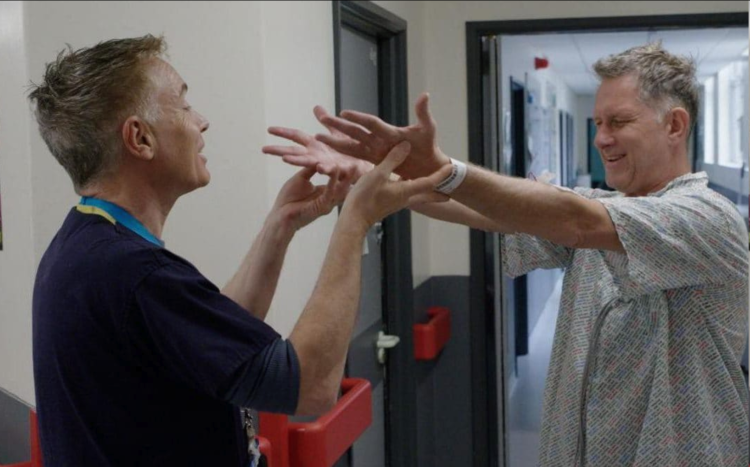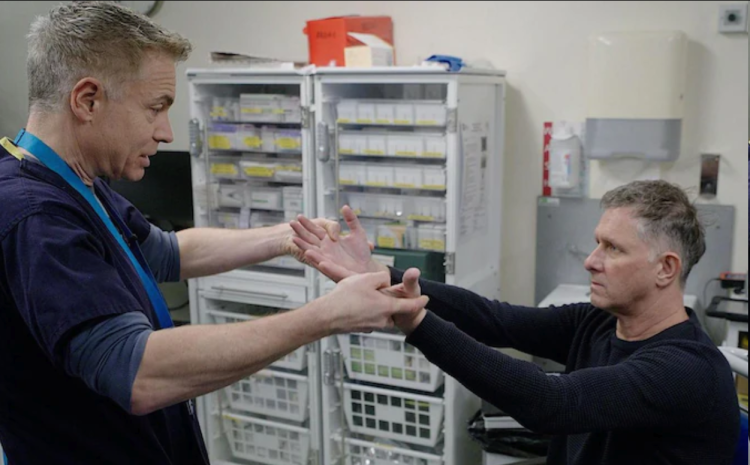AI brain scans help halfofstroke patientsfully recover
More than 60,000 people have had strokes diagnosed or ruled out since software was rolledout

*Shawn Theoff, right, recovered quickly after having an AI brain scan. He is pictured with David Hargroves, NHS stroke director
Almost half of stroke patients are making a full recovery because of AI brain scans rolled out across the NHS.
Deployed across the country, the software has sped up diagnosis by more than an hour, trebling the number of patients who recover fully.
It means about one in two patients diagnosed with a stroke will recover with no or minimal disability.
Health officials said the world-leading programme was “revolutionising” the diagnosis and treatment of stroke patients, in analysis published on the final day of the world’s largest heart conference.
Quick intervention is vital if stroke is suspected, with experts estimating that two million brain cells die every minute while someone awaits treatment.
Blood supply to part of the brain is blocked during a stroke. If not treated quickly, it can be fatal or cause permanent, long-term disabilities, such as paralysis, memory loss and communication issues.

*An AI brain scan allowed doctors to diagnose and administer drugs quickly to Shawn Theoff, right, and dissolve the blood clot in his brain
The new AI technology means brain scans can be rapidly processed and interpreted and shared between doctors, with patients receiving
a diagnosis and treatment sooner.
The more quickly patients receive life-saving interventions – such as thrombolysis, when a drug breaks down the blood clot, or mechanical
thrombectomy, where it is surgically removed – the better the chance of recovery.
More than 60,000 people have had strokes diagnosed or ruled out with the new AI tool since it was rolled out.
Analysis revealed that patients are receiving treatment 60 minutes more quickly after presenting with symptoms because of the AI scans.
It correlates to a trebling in the number of people who recover with no or only slight disability – defined as achieving functional independence – from 16 per cent to 48 per cent.
At the same time, the number of patients receiving thrombolysis increased from 11.6 per cent in 2023-24 to 12.3 per cent in 2024-25.
‘Revolutionary technology’
David Hargroves, the NHS national clinical director for stroke, said: “This AI decision support technology is revolutionising how we help people who have been affected by a stroke.
“It is estimated a patient loses around two million brain cells a minute at the start of a stroke, which is why rapid diagnosis and treatment is so critical.
“AI decision support software provides real-time interpretation of patients’ brain scans – supporting expert doctors and other NHS staff to make faster treatment decisions.
“NHS stroke teams have been leading the way in rolling out AI, and with every stroke centre now using the technology, it is already playing a key role in improving the care of thousands of people in England every year.”
More than 110,000 people were diagnosed with a stroke in 2023-24, up by almost a third on 20 years ago.
Wes Streeting, the Health Secretary, said those figures were “shocking”, especially because “the causes of stroke are largely preventable, such as high blood pressure and a poor diet”.

*Health Secretary Wes Streeting has called the rise in stroke figures in the UK ‘shocking’ Credit: Jordan Pettitt/PA Wire
Despite more people surviving a stroke than ever before, it is still the fourth leading cause of death in the UK, leading to about 38,000 deaths every year.
One man from Canterbury in Kent to have benefited from the AI brain scan is Shawn Theoff, who suffered a stroke shortly after returning from a holiday.
He was taken by ambulance to Kent and Canterbury Hospital and immediately given the scan, with doctors quickly able to diagnose and administer drugs to dissolve the blood clot in his brain.
As a result, he regained movement and sensation quickly and spent less than 48 hours in the hospital’s acute stroke unit before returning home.
______________________________________________________________________________________________________________________________________________________________
The first signs of a stroke include:
Face weakness – it might be hard to smile, and one side of your face may droop (fall)
Arm weakness – you may not be able to fully lift both arms and keep them there because of weakness or numbness in one arm
Speech problems – you may slur your words or sound confused
Other symptoms that could be the first sign you or someone else is having a stroke include:
Sudden weakness or numbness on one side of your body (including in your leg)
Sudden loss of vision or blurred vision in one or both eyes
Sudden difficulty speaking or thinking of words
Sudden memory loss or confusion
Sudden severe headache
Sudden dizziness, unsteadiness or a sudden fall, especially with any of the other signs
—————————————————————————————————————————————————————————————————
Mr Theoff, 56, said:
“I was making a coffee and all of a sudden I was knocking things over, and I couldn’t focus properly so I knew something wasn’t right.
“I couldn’t feel my hands and was struggling to use my phone. I eventually managed to get hold of my brother and he rang 999 for an anmbulance.
“I can’t thank the staff enough and I really feel that the speed of treatment I received has helped with my recovery. I was up and walking about in
the ward really quickly and I feel so lucky – I could’ve had serious issues.
“The treatment I got has given me a lifeline and I’m so thankful for that.”
The first symptoms of a stroke include: face weakness, such as drooping on one side and finding it hard to smile; arm weakness, where it may not be
possible to fully lift both arms up and keep them there; and speech problems, such as slurring words or sounding confused.